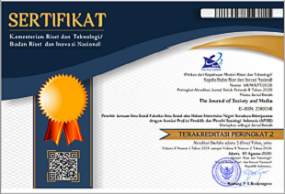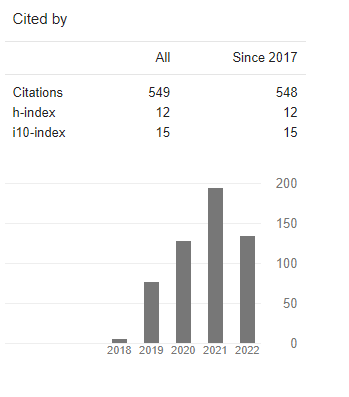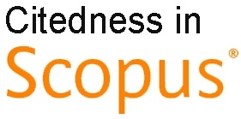The Effectiveness of Google Classroom as Asynchronous Learning Media in Civics Learning
DOI:
https://doi.org/10.26740/jsm.v5n1.p119-128Keywords:
Asynchronous learning, google classroom, civic education, e-learning methodAbstract
Learning through asynchronous google classroom media is considered a learning solution during a pandemic. Unlike learning through synchronous media, the limitations of accessing technological devices such as laptops and smartphones can be overcome in asynchronous learning in google classroom. The purpose of this study is to see the effectiveness of google classroom as an asynchronous medium that is still used by teachers in Civics learning.This study uses a quantitative approach.Descriptive statistics are used to measure the distribution of respondents' responses to the research questionnaire. The questionnaire was distributed within a span of 7 days via google form and 30 teachers were selected as respondents in this study. The results of this study indicate that google classroom as an asynchronous media tends to be used by teachers and is considered effective in learning Citizenship Education (Civics). This research has implications as a scientific reference so as to encourage the extensification of e-learning learning theory, and can be used as material for evaluation and formulation of policies in the scope of learning.
References
Basri, Megawati, Balqis Husain, dan Wiwin Modayama. 2021. œ"University Students Perceptions in Implementing Asynchronous Learning during Covid-19 Era". Metathesis: Journal of English Language, Literature, and Teaching 4(3):263.
Bolotnikov, A. .., R. Sh. Imangulov, dan R. N. Gimadeev. 2020. œ˜Competences of Social Interaction and Their Role in the Process of Physical Education. 114(19):63235.
Brady, Anna K. dan Deepak Pradhan. 2020. œ˜Learning without Borders: Asynchronous and Distance Learning in the Age of COVID-19 and Beyond. ATS Scholar 1(3):23342.
Daniati, Daniati, Bambang Ismanto, dan Dwi Iga Luhsasi. 2020. œ˜Upaya Peningkatan Motivasi Dan Hasil Belajar Mahasiswa Dengan Penerapan Model Pembelajaran ELearning Berbasis Google Classroom Pada Masa Pandemi Covid-19. Jurnal Kependidikan: Jurnal Hasil Penelitian dan Kajian Kepustakaan di Bidang Pendidikan, Pengajaran dan Pembelajaran 6(3):601.
Dey, Priyadarshini dan Somprakash Bandyopadhyay. 2019. œœBlended Learning to Improve Quality of Primary Education among Underprivileged School Children in India". Education and Information Technologies 24(3):19952016.
Hill, Kristy, Paul Bennett, dan Rachael Hunter. 2021. œœIts Social Interaction.. but Its Not: A Qualitative Study Investigating the Psycho-Social Experience of Social Media by Individuals with a Visual Impairment. Journal of Health Psychology.
Hrastinski, Stefan. 2008. œ˜Asynchronous and Synchronous E-Learning. Distributed Autonomous Robotic Systems 2:24556.
Insyiroh, Inas Mufidatul, Ela Puji Hariani, dan Syahrul Mubaroq. 2020. œ˜Pendidikan Berbasis Kearifan Lokal Sebagai Solusi Menghadapi Kesenjangan Digital Dalam Kebijakan Pembelajaran Jarak Jauh Pada Masa Pandemi Di Indonesia. Indonesian Journal of Social Development 1(1):5172.
Japar, Muhammad, Dini Nur Fadhilah, dan Syifa Syarifa. 2020. œ˜Pelatihan Penggunaan Google Classroom Dan Kahoot Untuk Meningkatkan Profesionalitas Guru Pendidikan Kewarganegaraan Di Era Digital. Jurnal Karya Abdi 4:1827.
Karalis, Thanassis dan Natassa Raikou. 2020. œ˜Teaching at the Times of COVID-19: Inferences and Implications for Higher Education Pedagogy. International Journal of Academic Research in Business and Social Sciences 10(5).
Kumar, Sanjaya. 2020. œœImpact of E-Learning Technologies in Higher Education Introduction". journal of ideal review 21:1218.
Lestari, Ayu Suci dan Gunawan. 2020. œ˜The Impact of Covid-19 Pandemic on Learning Implementation of Primary and Secondary School Levels. Indonesian Journal of Elementary and Childhood Education 1(2):6768.
Meier, Adrian dan Leonard Reinecke. 2020. œ˜Computer-Mediated Communication, Social Media, and Mental Health: A Conceptual and Empirical Meta-Review. Communication Research.
Mojica-Nava, Eduardo, David Yanguas-Rojas, dan César A. Uribe. 2020. œ˜Robust Asynchronous and Network-Independent Cooperative Learning.
Muhson, Ali. 2006. œ˜Teknik Analisis Kuantitatif. Makalah Teknik Analisis II 17.
Nieuwoudt, Johanna Elizabeth. 2020. œ˜Investigating Synchronous and Asynchronous Class Attendance as Predictors of Academic Success in Online Education. 36(3):1525.
Okmawati, Mike. 2020. œ˜The Use of Google Classroom during Pandemic. Journal of English Language Teaching 9(2):438.
Rabiman, Rabiman, Muhammad Nurtanto, dan Nur Kholifah. 2020. œ˜Design and Development E-Learning System by Learning Management System (Lms) in Vocational Education. International Journal of Scientific and Technology Research 9(1):105963.
Radha, R. K. Mahalakshmi, V. Sathish Kumar, dan A. R. Saravanakumar. 2020. œ˜E-Learning during Lockdown of Covid-19 Pandemic: A Global Perspective. International Journal of Control and Automation 13(4):108899.
Sadiah, Hilma Halimatus. 2020. œ˜The Effectiveness of Civic Education Online Learning on The Learning Participation of Students in Garut. Jurnal Kreatif Online d:8194.
Setiadi, Elly Malihah. 2020. Pengantar Ringkas Sosiologi (Pemahaman Fakta Dan Gejala Permasalahan Sosial). Jakarta: Kencana Prenada Media Group.
Sholah, Hanif Maulaniam. 2020. œ˜Teaching and Learning English Using Google. Jurnal Pusaka 8(1):112.
Silalahi, Ulber. 2015. 11 Journal of Visual Languages & Computing Metode Penelitian Sosial Kuantitatif. 4th ed. ed. Nurul Falah Atif. Bandung: PT Refika Aditama.
Sobaih, Abu Elnasr E., Ahmed M. Hasanein, dan Ahmed E. Ab. Elnasr. 2020. œ˜Responses to COVID-19 in Higher Education: Social Media Usage for Sustaining Formal Academic Communication in Developing Countries. Sustainability (Switzerland) 12(16):118.
Sudarsana, I. Ketut, I. Ida Bagus Made Anggara Putra, I. Nyoman Temon Astawa, dan I. Wayan Lali Yogantara. 2019. œ˜The Use of Google Classroom in the Learning Process. Journal of Physics: Conference Series 1175(1).
Supriyanto, Agus et al. 2020. œ˜Teacher Professional Quality: Counselling Services with Technology in Pandemic Covid-19. Counsellia: Jurnal Bimbingan dan Konseling 10(2):176.
Syah, Rizqon H. 2020. œ˜Dampak Covid-19 Pada Pendidikan Di Indonesia: Sekolah, Keterampilan, Dan Proses Pembelajaran. SALAM: Jurnal Sosial dan Budaya Syar-i 7(5).
Wong, Ruth. 2020. œœWhen No One Can Go to School: Does Online Learning Meet Students Basic Learning Needs?. Interactive Learning Environments 3:117.
Zakaria, Maheran, Faculty Accountancy, Universiti Teknologi Mara, dan Cawangan Kelantan. 2021. œBenefits and Challenges of Adopting Google Classroom in Malaysian University: Educators Perspectives. Ä°lköğretim Online 20(1):12961304.
Zuriah, Nurul. 2020. œ˜Strategy for Implementing Blended Learning With Google Classroom during the COVID-19 Pandemic Era in Higher Education. Advances in Social Science, Education and Humanities Research 477(Iccd) 55963.
Downloads
Additional Files
Published
How to Cite
Issue
Section
 Abstract views: 668
,
Abstract views: 668
, PDF Downloads: 845
,
PDF Downloads: 845
, PDF Downloads: 0
PDF Downloads: 0












